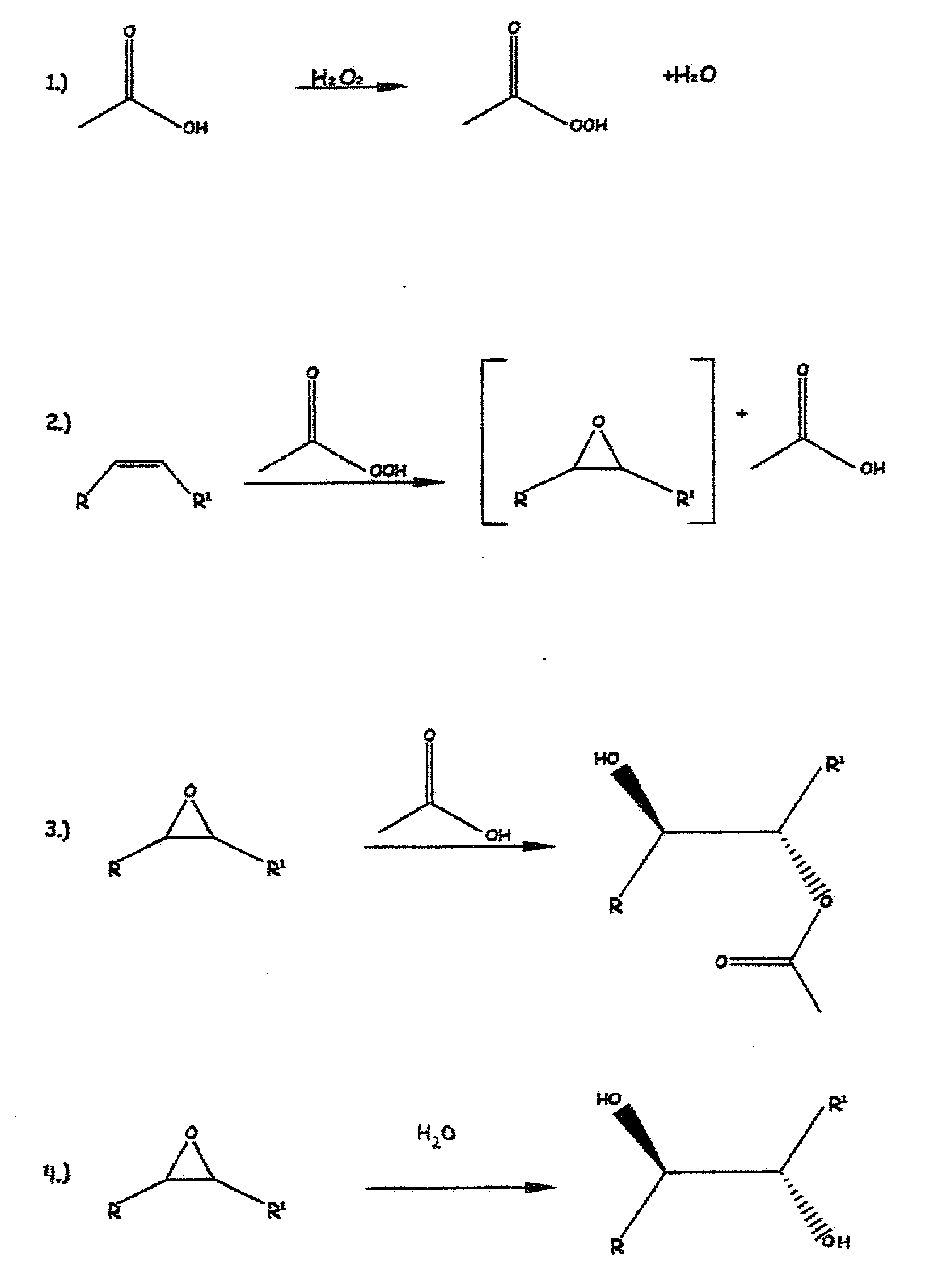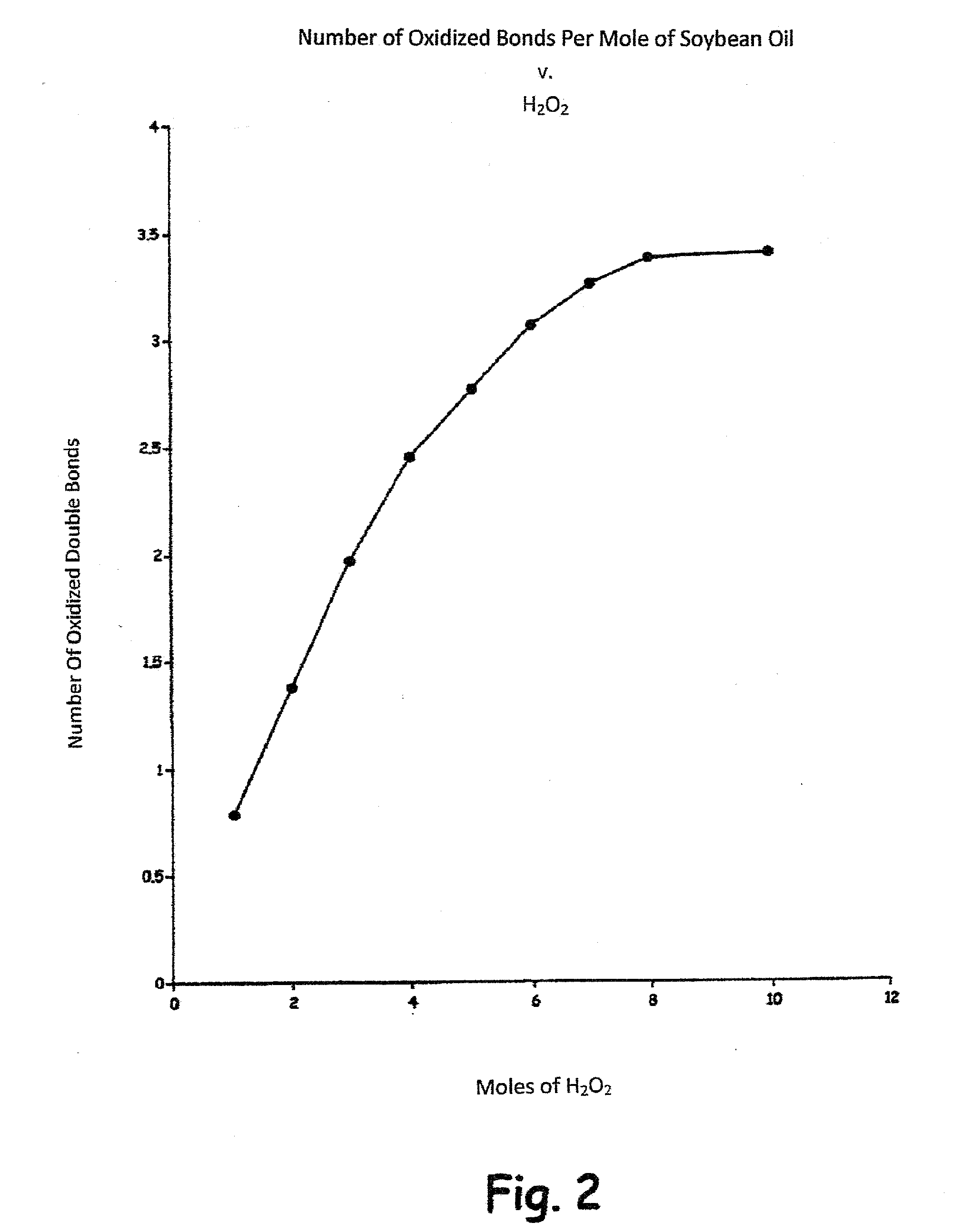Methods of preparing hydroxy functional vegetable oils
a vegetable oil and functional technology, applied in the field of sustainable technologies and sustainable polymer chemistry, can solve the problems of unacceptably tinting any polymer, many known vegetable based polyols have unpleasant odor, and products that have commercially detrimental aesthetic qualities, and achieve the effect of simple and efficien
- Summary
- Abstract
- Description
- Claims
- Application Information
AI Technical Summary
Benefits of technology
Problems solved by technology
Method used
Image
Examples
example 6
[0121]This example discusses the handling of the discharge streams from the prior example (Example 5).
[0122]There were four discharge streams of interest, namely, the aqueous phase from the reaction, the distillate from the degasser, the distillate from the first pass on the wiping film evaporator, and the distillate from the second wiping film evaporator.
[0123]The aqueous phase isolated from the reaction contained recoverable quantities of acetic acid, water and polyol. After separation, the stream was analyzed for the components set forth above. The results were used to adjust the charge of pure acetic acid, and water to the next reaction. Approximately 80% to 85% w / w of the stream was recycled to the next batch. The remainder, about 15% to 20% w / w was quenched with sodium metabisulphite and transferred to the fractional distillation column for recovery of acetic acid.
[0124]The distillate recovered from the wiping film evaporators was transferred to a fractional distillation colum...
example 7
[0126]A 60 gallon 316L stainless steel reactor equipped with an agitator and a reflux condenser was passivated and purged with nitrogen. The agitator was started and the reactor was vented through the reflux condenser. Coolant was applied to the reflux condenser and a nitrogen sweep on the reactor began.
[0127]The reactor was charged with 192 pounds of RBD (refined, bleached deodorized) soybean oil followed by 102 pounds of glacial acetic acid, and 41 pounds of distilled water. The reactants were allowed to mix for 15 minutes with agitation. The reactor was sealed and heated to 110° C. with agitation that created a pressure of about 20 to 25 psig.
[0128]Forty one (41) pounds of 70% hydrogen peroxide was metered from a day tank to the reactor over 120 minutes at a rate of 0.34 pounds / minute. The reactor pressure ranged between about 30 to 35 psig. Coolant was applied to the reactor jacket as needed to control the batch temperature at 110° C. plus or minus 2° C. during the hydrogen pero...
example 8
Odor Testing
[0137]This example was carried out to test the odor of the polyols produced by the process as set forth in Examples 1-3. Tested were polyols of 117, 168, and 185 hydroxyl numbers. (See Tables I-III). All three polyols were visually clear.
[0138]The above-mentioned polyols were compared against the following polyols. Arcol® LG-168, a petroleum-based polyether triol made by the addition of propylene oxide to a glycerin-based initiator compound. The material is available from Bayer Material Science Corporation and has typical properties of 1000 molecular weight, water white color, visual clarity, characteristic polyether polyol odor, terminal secondary hydroxyls and a hydroxyl number in the range of 158 to 178 mg KOH / g. Soyol® R3-170E, is a soybean oil-based product designed for use in a wide range of polyurethane applications. The material is available from the Urethane Soy Systems Company. Reported properties are: a functionality of 3, a hydroxyl number in the range of 160...
PUM
| Property | Measurement | Unit |
|---|---|---|
| temperature | aaaaa | aaaaa |
| temperature | aaaaa | aaaaa |
| temperature | aaaaa | aaaaa |
Abstract
Description
Claims
Application Information
 Login to View More
Login to View More - R&D
- Intellectual Property
- Life Sciences
- Materials
- Tech Scout
- Unparalleled Data Quality
- Higher Quality Content
- 60% Fewer Hallucinations
Browse by: Latest US Patents, China's latest patents, Technical Efficacy Thesaurus, Application Domain, Technology Topic, Popular Technical Reports.
© 2025 PatSnap. All rights reserved.Legal|Privacy policy|Modern Slavery Act Transparency Statement|Sitemap|About US| Contact US: help@patsnap.com



